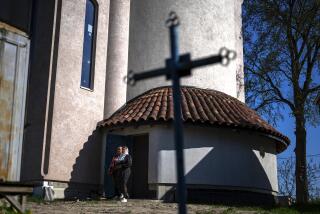CULTURE : Resurrection to Atone for Sins of Soviet Past : Yeltsin says rebuilding a Moscow temple destroyed by Stalin will herald a return to Russia’s lost heritage.
MOSCOW — If one piece of real estate symbolizes the struggle for Russia’s soul, it is a 984-foot-wide pit by the Moscow River not far from the Kremlin.
Until last week, when construction workers fenced it off and drained it, the place was a complex of outdoor swimming pools. But that was only one chapter in a bizarre history now coming full circle.
In Chapter One, the world’s largest Orthodox cathedral stood there. Consecrated in 1883, the Temple of Christ the Savior accommodated 15,000 worshipers, a grandiose monument to the dual authority--secular and divine--of the czar.
In Chapter Two, Christ the Savior became one of the world’s largest demolition projects when Soviet dictator Josef Stalin decided to replace it with a temple to Communist supremacy. Looted and dynamited, the cathedral crumbled in 1931 and Stalin commissioned work on a Palace of Soviets that was to stand taller than the Empire State Building.
But the swampy site proved incapable of supporting such a monster--divine punishment, believers say. With the coming of World War II, and then Stalin’s death, the palace never got off the ground.
Chapter Three, in 1960, saw the abandoned site turned into a network of heated pools, where bathers could frolic in subfreezing weather while steam rose from the water.
Now, in Chapter Four, the Russian Orthodox patriarch and Moscow Mayor Yuri M. Luzhkov have unveiled plans to rebuild Christ the Savior on its original site and according to Konstantin Ton’s 19th-Century design. Luzhkov assigned Mospromstroi, a construction company controlled by the city, to start work.
The project and its estimated minimum $300-million price tag are as controversial as the history behind it.
Backers, including President Boris N. Yeltsin, say Russia needs the cathedral to herald the return of its lost culture and religion, to atone for excesses of its Soviet past. Critics call the cathedral, built to commemorate Russia’s defeat of Napoleon in 1812, a waste of money and an inappropriate salute to militarism.
“It is time to start this sacred venture,” the mayor said in announcing the project. “Russia is ready financially and, what is more important, morally. Our generation should compensate for the huge damage done to our cathedrals, to the Russian Orthodox Church, to the Russian people.”
Since Soviet authorities ended restrictions on religious life five years ago, thousands of Orthodox parishes have sprung to life. Yeltsin and other post-Soviet leaders find it politically prudent to attend services and adopt the causes of Russia’s dominant church.
Luzhkov and Alexy II, the Orthodox patriarch, have set up a foundation that is supposed to finance the new cathedral entirely with private money--from the church and its faithful, from bankers and other newly rich entrepreneurs who want their names on a plaque.
Skeptics cite Czar Alexander I’s promise that the original cathedral would be paid for by donations; it ended up costing the state a fortune over 45 years of construction that dragged on after his death.
“If the church is separated from the state, let it build the cathedral and not stretch its hand into my pocket,” said Maria Lukashenko, a Moscow mother of three.
The timing of the project is politically driven. Luzhkov wants the outer structure restored for Moscow’s 850th birthday in 1997 and the inside finished for services by the year 2000.
For such an ambitious work in Russia, the timetable will be hard to meet. And it is uncertain whether the builders can duplicate the 19th-Century techniques that supported a cathedral more than 30 stories high, laden with marble and granite.
Some critics say the remake cannot be more than an imitation, because so many splendid original icons, sculptures and frescoes were looted. The city is appealing for their return and hopes to get the main altar and dazzling iconostasis back from the Vatican.
Others question whether $300 million would be better spent restoring parish churches and religious life--”the only assurance that the cathedral will not be left empty in future years,” Dmitry Popov wrote in the Moscow Times.
On the whole, though, the idea of a new cathedral is popular in Moscow; one opinion survey showed 65% backing.
“I remember Christ the Savior cathedral from my childhood,” A. P. Dyachenko, 80, wrote to a Moscow newspaper. “It was so big, and I was so small. I thought that it was God Himself. It must be restored, no question.”
More to Read
Sign up for Essential California
The most important California stories and recommendations in your inbox every morning.
You may occasionally receive promotional content from the Los Angeles Times.










